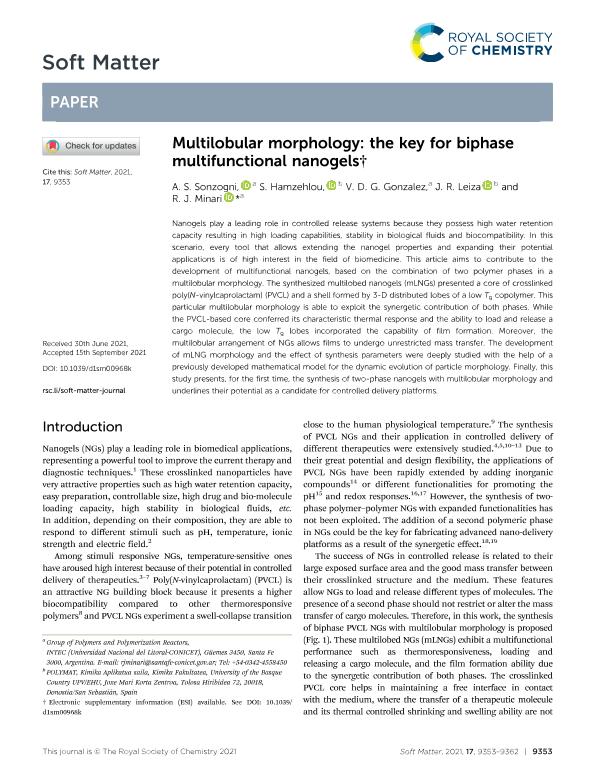Mostrar el registro sencillo del ítem
dc.contributor.author
Sonzogni, Ana Sofía

dc.contributor.author
Hamzehlou, Shaghayegh
dc.contributor.author
González, Verónica Doris Guadalupe

dc.contributor.author
Leiza, Jose Ramon
dc.contributor.author
Minari, Roque Javier

dc.date.available
2022-01-18T14:23:48Z
dc.date.issued
2021-09
dc.identifier.citation
Sonzogni, Ana Sofía; Hamzehlou, Shaghayegh; González, Verónica Doris Guadalupe; Leiza, Jose Ramon; Minari, Roque Javier; Multilobular morphology: the key for biphase multitask nanogels; Royal Society of Chemistry; Soft Matter; 17; 41; 9-2021; 9353-9362
dc.identifier.issn
1744-683X
dc.identifier.uri
http://hdl.handle.net/11336/150217
dc.description.abstract
Nanogels play a leading role in controlled release systems because they possess high water retention capacity resulting in high loading capabilities, stability in biological fluids and biocompatibility. In this scenario, every tool that allows extending the nanogel properties and expanding their potential applications is of high interest in the field of biomedicine. This article aims to contribute to the development of multifunctional nanogels, based on the combination of two polymer phases in a multilobular morphology. The synthesized multilobed nanogels (mLNGs) presented a core of crosslinked poly(N-vinylcaprolactam) (PVCL) and a shell formed by 3-D distributed lobes of a lowTgcopolymer. This particular multilobular morphology is able to exploit the synergetic contribution of both phases. While the PVCL-based core conferred its characteristic thermal response and the ability to load and release a cargo molecule, the lowTglobes incorporated the capability of film formation. Moreover, the multilobular arrangement of NGs allows films to undergo unrestricted mass transfer. The development of mLNG morphology and the effect of synthesis parameters were deeply studied with the help of a previously developed mathematical model for the dynamic evolution of particle morphology. Finally, this study presents, for the first time, the synthesis of two-phase nanogels with multilobular morphology and underlines their potential as a candidate for controlled delivery platforms.
dc.format
application/pdf
dc.language.iso
eng
dc.publisher
Royal Society of Chemistry

dc.rights
info:eu-repo/semantics/openAccess
dc.rights.uri
https://creativecommons.org/licenses/by-nc-sa/2.5/ar/
dc.subject
NANOGELS
dc.subject
FILM FORMING
dc.subject
MULTIFUNCTIONAL NANO-PLATFORM
dc.subject.classification
Recubrimientos y Películas

dc.subject.classification
Ingeniería de los Materiales

dc.subject.classification
INGENIERÍAS Y TECNOLOGÍAS

dc.title
Multilobular morphology: the key for biphase multitask nanogels
dc.type
info:eu-repo/semantics/article
dc.type
info:ar-repo/semantics/artículo
dc.type
info:eu-repo/semantics/publishedVersion
dc.date.updated
2021-12-13T18:50:34Z
dc.journal.volume
17
dc.journal.number
41
dc.journal.pagination
9353-9362
dc.journal.pais
Reino Unido

dc.journal.ciudad
Cambridge
dc.description.fil
Fil: Sonzogni, Ana Sofía. Consejo Nacional de Investigaciones Científicas y Técnicas. Centro Científico Tecnológico Conicet - Santa Fe. Instituto de Desarrollo Tecnológico para la Industria Química. Universidad Nacional del Litoral. Instituto de Desarrollo Tecnológico para la Industria Química; Argentina
dc.description.fil
Fil: Hamzehlou, Shaghayegh. Universidad del País Vasco; España
dc.description.fil
Fil: González, Verónica Doris Guadalupe. Consejo Nacional de Investigaciones Científicas y Técnicas. Centro Científico Tecnológico Conicet - Santa Fe. Instituto de Desarrollo Tecnológico para la Industria Química. Universidad Nacional del Litoral. Instituto de Desarrollo Tecnológico para la Industria Química; Argentina
dc.description.fil
Fil: Leiza, Jose Ramon. Universidad del País Vasco; España
dc.description.fil
Fil: Minari, Roque Javier. Consejo Nacional de Investigaciones Científicas y Técnicas. Centro Científico Tecnológico Conicet - Santa Fe. Instituto de Desarrollo Tecnológico para la Industria Química. Universidad Nacional del Litoral. Instituto de Desarrollo Tecnológico para la Industria Química; Argentina
dc.journal.title
Soft Matter

dc.relation.alternativeid
info:eu-repo/semantics/altIdentifier/url/http://pubs.rsc.org/en/Content/ArticleLanding/2021/SM/D1SM00968K
dc.relation.alternativeid
info:eu-repo/semantics/altIdentifier/doi/http://dx.doi.org/10.1039/D1SM00968K
Archivos asociados
